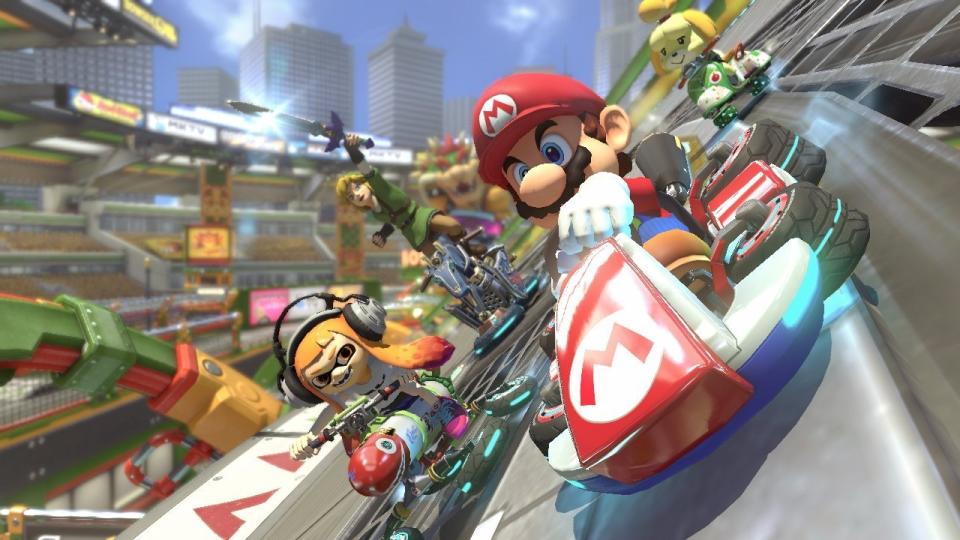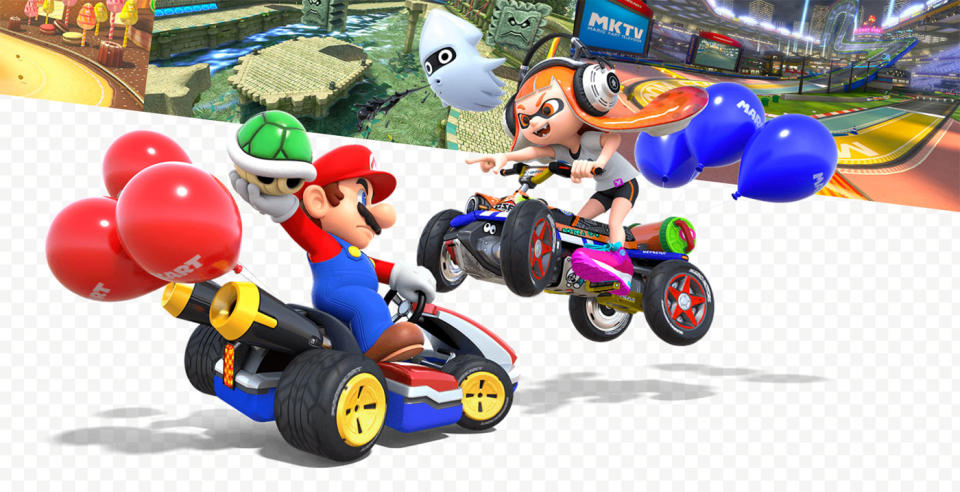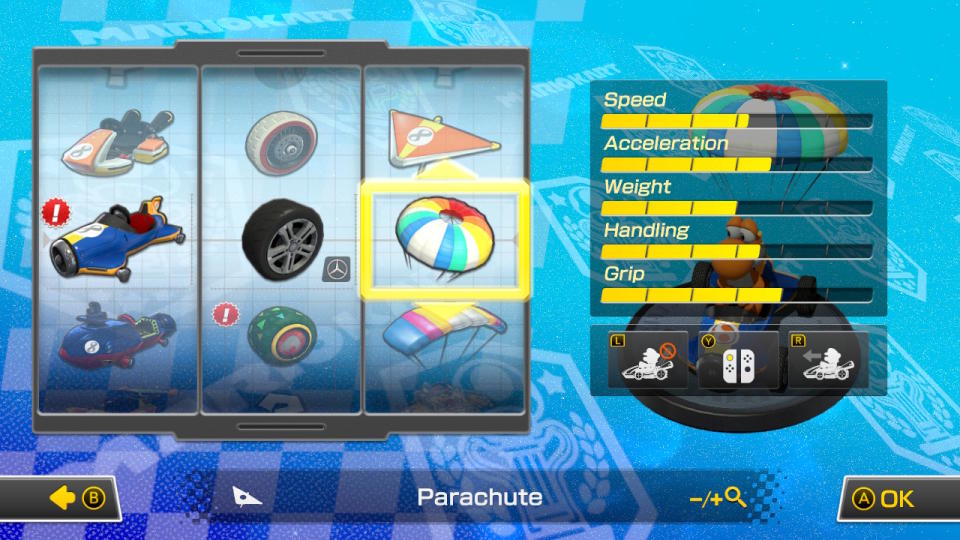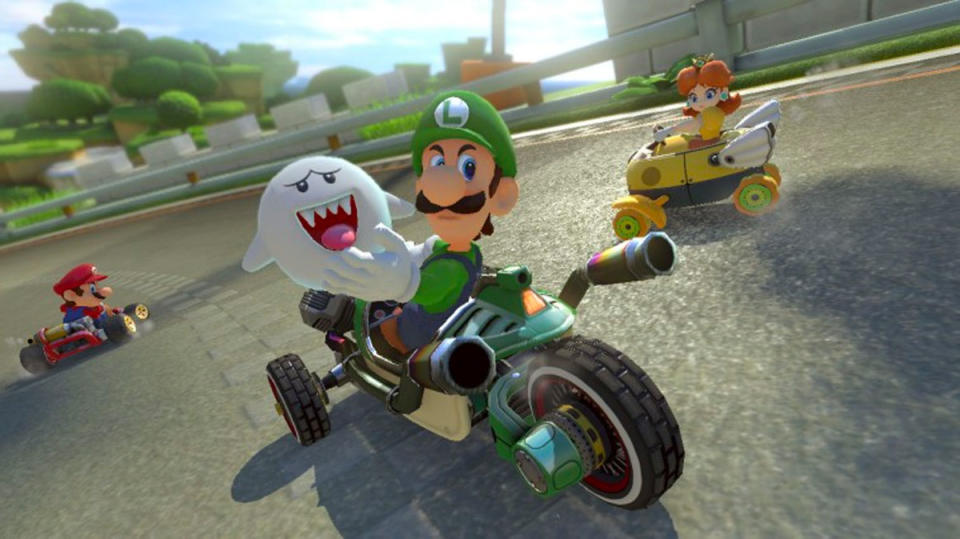'Mario Kart 8 Deluxe' on the Switch is basically perfect
The Engadget team thinks so. Well, with one exception.

Mario Kart 8 Deluxe is poised to be the next must-have Switch game. Regardless of the last Mario Kart title you played -- our experiences vary from Mario Kart 64 to DS iterations to the Wii U's original Mario Kart 8 -- Nintendo is aiming to make this the most definitive Mario racer yet. To start, there are 48 courses and 42 characters (including some Splatoon additions), as well as an upgraded 1080p mode when you're playing it docked from the Switch and some auto-steering help for younger gamers (or grown-ups who should know better). Those Joy-Con controllers double as mini-controllers for two-player battles on the go, while a fully fleshed-out battle mode, with several arenas and play modes, form the biggest gameplay addition to the original that launched on the Wii U. Now, you probably knew most of that already, but how does it play? Four editors share their thoughts after a week of racing, while one colleague swears he won't buy the remake, regardless of how good it might be.

Jessica Conditt
Senior Reporter
The Joy-Cons shouldn't work. The two tiny controllers that lock into place on either side of the Nintendo Switch's main screen should be too small, cluttered and uncomfortable to work as fully fledged gamepads. But, magically, they do.
When we first got the Switch, my partner and I each broke off a Joy-Con and played a few rounds of Snipperclips, but we didn't really test out the individual gamepads until Mario Kart 8 Deluxe. We were excited: We'd conquered the original game on the Wii U, playing together, alone and with roommates for months on end (all with traditional gamepads, of course).
Before Mario Kart 8 Deluxe, the Switch had mainly functioned as a single-player Zelda machine in my house. This means we didn't need extra gamepads like the Nintendo Switch Pro Controller, which costs $70 for some ungodly reason. So when my partner and I sat down to play MK8D, we popped out the Joy-Cons -- and hesitated.
They were so small. We'd used them before, but not for hours on end, and not as stand-ins for traditional gamepads. The face of each controller has an analog stick on the left side, an array of four action buttons and either the Home or Camera button. The Joy-Cons' bumpers -- crucial buttons for drifting in Mario Kart 8 -- are minuscule rectangles flush with the "top" of each controller, so that they actually disappear when reattached to the Switch.
It simply didn't seem possible that this ridiculously light, palm-size gamepad would be able to compete with something like the Pro Controller. However, to my surprise, it did.
After rolling through one track, my hands had naturally found a comfortable position on the Joy-Con. After two tracks, I wasn't thinking about missing the bumper or getting a cramp; my attention was on the screen, immersed in the race. By the time we'd finished two full rounds, my partner and I were marveling at the game all over again, impossible gamepads and all.
MKD8 is a beautiful game. Its upgrades are crisp and endearing, and it's a welcome addition to the Switch, even though I played the original title into the ground. And, yes, even with the Joy-Cons.

Mat Smith
UK Bureau Chief
Mario Kart DS, released in 2005, was the last Mario Kart title I owned. This meant I was instantly wowed by the sumptuous glossiness of Mario Kart 8 Deluxe. There's the vibrant, animated characters, the huge attention to detail that you'll see only when the action replay slows everything down, and these incredibly grand vistas to race around. Nintendo's made bigger, wider tracks to accommodate up to 12 racers, as well as adding gravity-defying hover tires and automatic gliders for when you soar off ramps. (This was all new to me.)
Now, even before MKDS, I used to be pretty good at Mario Kart 64. I wasn't the best, but I'd challenge my mates for pole position and occasionally claim it myself. Alas, that was decades ago. In the now, in 2017, I'm not very good at Mario Kart 8. It's a fact that's been (repeatedly) proven both on- and offline. (For the record, I've bested my colleague racers once out of twelve races. That's pretty awful.)
I think it's because I never had to worry about online rivals when I was playing on an N64 or my DS. I just had to worry about my buddies, their buddies, and the occasional sibling. When it comes to the Switch, there's no lack of people to play against online -- except they're all better than me. Much better, with many of them presumably putting in the hours to master the Wii U original. (Please read further below for some examples of these monsters.)

I wouldn't put it all down to my sheer lack of natural karting talent. I think it's because Mario Kart, over all these iterations, has become more complex. Not only are there 48 tracks to both learn and (maybe) master; there are 42 characters, with acceleration and weight differences. Add to that vehicle customization: over 26 karts, bikes and ATVs, plus your pick of tires and gliders with minute (but presumably important) speed and handling differences -- that's a lot to work with. So I don't. At least not in these first initial weeks of playing. I came here to play Mario Kart, not beat myself up over tire choices.
Fortunately, MK8D offers another option: an expanded battle mode. Balloon Battle, which hasn't changed much, is joined by Coin Runners (collect more than anyone else to win) and Shine Thief, a constantly moving iteration of capture the flag, but with a Shine Sprite. If you're holding the sprite, your own speed takes a hit, which keeps things interesting. My favorite, however, is the new Renegade Roundup, which is cops-and-robbers but with that Mario staple Pirahna Plants. As change-around is so swift (and weapons so plentiful), it turns into a game that's downright chaotic. In a fun way. This is tiding me over until I suck less at the racing, and it's the crux of what this game does so well. Even without the built-in steering assistant, it's a rare multiplayer game that can be instantly played (and enjoyed) by anyone, regardless of their Mario Kart prowess.

Matt Brian
Managing Editor, Engadget UK
Until Mario Kart 8 Deluxe arrived at my house, the Nintendo Switch was sacred. I had one game, Zelda: Breath of the Wild, and my two boys -- aged six and seven -- weren't allowed to touch it. It's not because I'm a bad father (although you could argue otherwise), but because the Switch feels surprisingly fragile undocked, and they had barely scratched the surface of Ocarina of Time on the Nintendo 3DS. However, that changed when a neon box arrived, advertising Nintendo's latest take on its smash race series. It suddenly became very easy to hand out the Joy-Cons and attempt to show the kids who's the boss.
Mario Kart 8 Deluxe offers two new features aimed at beginners and younger players: smart steering and auto-acceleration. If you've played racing games with children before, you know that fast cars and twisting courses can lead to upset and ultimately result in the loss of a racing buddy. Nintendo knew this, so it placed a small antenna on the back of each kart, a visual cue that lets you know that the console will help keep racers on the track and pointed in the right direction -- even when racing in 200cc mode. Inside the game, you can toggle the feature on or off when selecting your kart by hitting the plus and minus buttons (although it's not very obvious and took me a while to find).

I knew that before I selected the first series of four races on the Mushroom Cup, racing my kids wouldn't be easy. Like most boys a year apart in age, they're fiercely competitive and had already honed their Mario Kart skills on the original Wii and 3DS. In practice, they were more than proficient, boosting around corners and finding shortcuts that I had barely noticed. I won, but make no mistake: The game's automated guidance kept them (and occasionally me) in the running a lot of the time.
From my experience, Nintendo has created a racing system that accounts for fine margins. Sure, you can put the Joy-Con or Pro Controller down and the game will complete the race on your behalf (in some cases winning), but it's also adept at recognizing when a player isn't new to Mario Kart. Attempt a drift too late or too early and the auto-steer function will kick in, but you'll lose nearly all of your momentum, allowing human and AI racers to catch up. It won't just let you mash the 'A' button and zip around the course with no regard for the layout of the track.
While Nintendo has dialed down rookie driver frustrations, it's still kept the essence of what makes Mario Kart, erm, Mario Kart. As a teenager, I remember getting into arguments over Mario Kart 64 when my friends would "blue shell" me while leading on the final corner of the last lap. Going from first to third in a couple of seconds will always leave me salty. In MK8D, power-ups are often unrelenting (you can carry two weapons at a time), and in all honesty were the only real bone of contention with my boys.
It's pretty hard to temper a child's frustration when he feels he's racing well and he gets hit by an ink attack, shrunk by lightning and then hit by a barrage of red shells, causing them to slide down the ranks. However, I think I'd rather have that than have them constantly slide off the side of Rainbow Road and generally find it hard to keep the kart moving forward at speed. My kids are constantly begging me to play, so I can only see that as a good thing.

Sean Buckley
Associate Editor
Despite being an ardent Nintendo fanboy, the announcement of Mario Kart 8 Deluxe for Nintendo Switch did little to stir my interest. Of all the games announced between the console's first reveal and its official launch, it was by far the least interesting. Sure, Mario Kart 8 was a great game -- but it was also "just a port," a game I'd already played to exhaustion. Like the HD remaster of The Legend of Zelda: Wind Waker on the Wii U, I expected it to hold my attention for a weekend or two at best before fading to the back of my library. Instead, the game has dominated my Switch playtime for the past few weeks. Maybe I'm wrong about Switch remasters of Wii U games.

From a purely clinical point of view, my knee-jerk reaction wasn't wrong. For the most part, Mario Kart 8 Deluxe is the exact same game I grew tired of on the Wii U -- the same tracks, most of the same characters and, with the exception of a few bonus multiplayer modes, all the same features. And indeed, the first evening I tried it on my TV, I found replaying it all pretty underwhelming. The next day, however, I took my Switch out of the dock and played it in the bedroom. Then I took it to a friend's house and played local multiplayer. The next weekend, I brought it with me to Silicon Valley Comic Con and played both single-player Grand Prix and local multiplayer battles while waiting in line for panels and talks. The game hadn't changed much, but the experience had.
Ultimately, this is a story I've told before. The Nintendo Switch's portability has consistently surprised me at every turn -- not only by keeping me entertained on the go, but by enabling bespoke social experiences on the fly. I knew this worked with games like Puyo Puyo Tetris and Snipperclips, but I didn't expect the hybrid nature of the console to revitalize a game I'd already put aside. If the Nintendo Switch was nothing but a typical TV console, I probably wouldn't have played the game for more than a few hours. Instead, I'm obsessed with it again -- challenging friends, trying new Kart combinations and struggling to learn how to drive in 200cc mode. Last month, the idea of porting old games to the Nintendo Switch sounding dull to me. Now, the idea sounds amazing. I'm starting to wonder if I would have given up on Wind Waker HD if it was this easy to pick up and play.

Jamie Rigg
Reviews Editor, Engadget UK
I love Mario Kart 8. It's the first racing title I've been truly enamored with since turn-of-the-century PlayStation classics Gran Turismo 2 and Crash Team Racing. Back when MK8 was first released, I studied vehicle and character attributes, risk-assessed shortcuts and bested every challenge the game offered. At the time, I returned to it regularly in an attempt to shave milliseconds off my best lap splits, occasionally hopping online to demoralize opponents with my newly perfected lines. Both DLC packs were immediate purchases. And yet, there's absolutely no chance I'm revisiting the fantastic game on the Switch with Mario Kart 8 Deluxe.
Perhaps I'm bordering on hypocritical, because I don't think ports and other forms of re-release are always a bad thing. As a former Halo 2 addict, I was fidgeting with excitement the day Halo: The Master Chief Collection was due to be delivered, only to abandon the game when its fundamentally broken multiplayer element irreparably soured my perception.
I can even understand the hype Call of Duty: Modern Warfare Remastered generated. For as long as I can remember, every new entry in the Call of Duty franchise has felt like the same chaotic shooter with new box art. That gamers would want to revisit Modern Warfare and play the first title that was set outside World War II, when there was still some originality to the series, makes sense.
But Modern Warfare Remastered hasn't turned out to be a particularly fan-friendly affair. The game, available solely as a bonus within the "Legacy Edition" of Call of Duty: Infinite Warfare, doesn't include the original's DLC map packs. The cherry on top is that these additional battleground bundles are now nearly twice the price they were ten years ago when Modern Warfare was first released. There's been a renewed outrage this week in certain corners of the internet (and rightly so) when the Variety Map Pack DLC landed on Xbox One and PCs -- and I regard Mario Kart 8 Deluxe with similar sentiment.
The obvious rebuttal is: "Shut up and stop moaning ... nobody is forcing you to buy it."
I paid £40 for Mario Kart 8 when it first came out, and shelled out (pun intended) a further £14 on the two DLC packs, taking my total spend to around £54 (roughly $70 at the current exchange rate). And that's not even factoring in that MK8 was the primary reason for buying a Wii U more than a year after the system launched in the first place. And now Nintendo thinks I'll spend more than £40 to buy basically the same game again for the Switch? Fat chance.
The obvious rebuttal is: "Shut up and stop moaning ... nobody is forcing you to buy it." It's a fair point, but it's not just the money situation I'm frustrated by (even if my only meaningful avenue of protest is to boycott the game — voting with my wallet, as they say). The thing is, I almost want MK8D. Not for the couple of extra vehicles and Splatoon characters, nor the improved battle mode, which still doesn't amount to enough additional content for my liking. It's more that the Switch hardware makes multiplayer so much more accessible, letting you face off with a friend, each with one little Joy-Con in hand, or pairing multiple handhelds locally for serious sessions.
If it were a cheap, download-only port, or if Nintendo at least offered a heavy discount to owners of the Wii U version, I could maybe entertain picking it up. But like I said, it's not just about the money. I think it's a pretty lazy, unimaginative attempt by Nintendo to pad out a sparse launch lineup -- which Zelda: Breath of the Wild is propping up almost exclusively at this point -- while making a quick and easy buck from everyone caught up in the Switch fanfare. And selling it for the same price as the original, three-year-old game is the icing on the unpleasant, greedy cake.
At least I have a new NBA Jam to look forward to.
